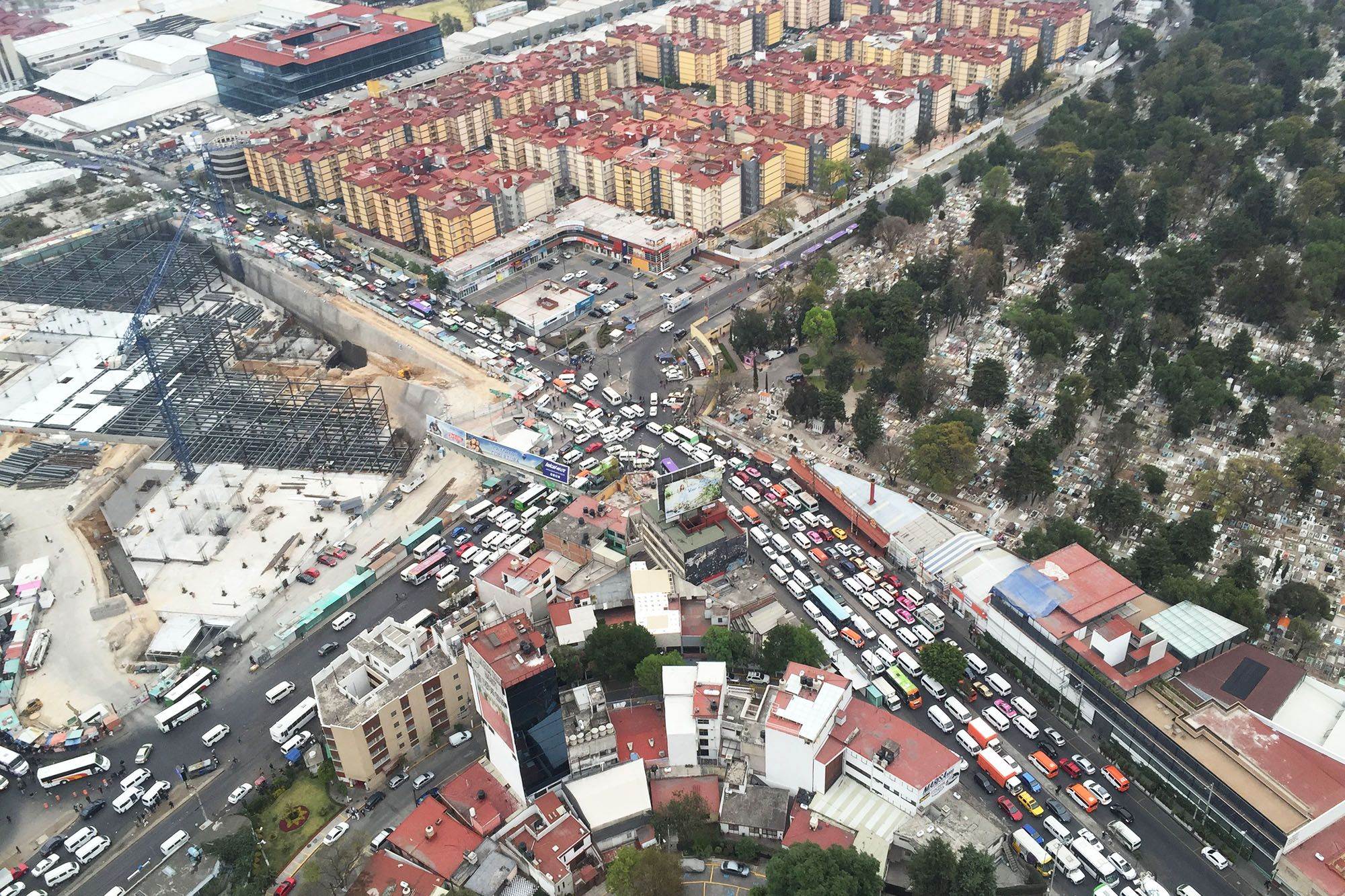
More than 20 million people live in metropolitan Mexico City, and most spend upwards of three hours a day riding to and from work, stuck in traffic jams.
The region has one of the world’s largest urban rail (metro) systems in the world, but most passenger traffic is concentrated on a few lines that serve the city center. Stations farther out are difficult to reach on foot and offer few amenities for commuters or residents.
“As an occasional visitor, I was always perplexed by Mexico City,” said P. Christopher Zegras, associate professor of transportation and urban planning in MIT’s Department of Urban Studies and Planning (DUSP). “The city has this exceptional infrastructure and metro, but seemed to take relatively little advantage of it.”
In spring 2016, Zegras co-taught a DUSP graduate practicum in which students traveled to Mexico City to study the potential of linking public transport and development.
Titled “Transit-Oriented Development in a Mega City,” the course examined the applicability of transit-oriented development (TOD) principles to Mexico City. This approach requires engaging multiple stakeholders — government officials, local businesses, residents, transit authorities, and private developers — to collaborate in creating sustainable mixed-use communities built around mass transit stations.
In December, their findings were presented to a packed room of urban planners, transit personnel, national media, and government officials, including Laura Ballesteros, Mexico City’s Undersecretary of Planning at the Ministry of Mobility, at the city government’s downtown Laboratory for the City. There were also private meetings with Xochitl Gálvez, District Mayor of Miguel Hidalgo, and Felipe de Jesús Gutiérrez, Mexico City’s Secretary of Urban Development and Housing.
“The recommendations align perfectly with the public policies and actions that the city government is promoting now — going against the old mobility scheme, looking toward a more sustainable and human city model,” said Ballesteros.
“The good news is that there are concrete actions that can be taken to reverse the haphazard growth and low-quality mobility that characterize our city,” said Onésimo Flores PhD ’13, who co-taught the course as a visiting lecturer at MIT. Flores is now CEO of Conecta Cuatro, a company that promotes innovative technology ventures to tackle urban and transportation problems in Mexico.
“During the last 30 years the population in the central boroughs has diminished, even though in these areas you will easily find a mass transit station within a 10-minute walk,” said Flores. “Taking all the metro stations, we could probably build around 70,000 housing units on their surrounding land and help bring back the people who work in the inner city.”
The client and sponsor for the practicum was Grupo Prodi, a private developer and operator of multimodal transit stations in Mexico City. “It’s clear that transit-oriented development can be the key to improving quality of life in urban areas not only in Mexico City, but also in cities like Monterey and Guadalajara,” said José Miguel Bejos, Grupo Prodi CEO.
“The practicum contributed to Grupo Prodi’s vision to promote new standards in the development of transportation infrastructure designed with the needs of the user, the neighborhoods, and the city in mind,” Bejos said. “We firmly believe that we need to find practical long-term solutions to the present urban challenges.”
When successfully implemented, transit-oriented development can provide residents with a high-quality urban lifestyle, create walkable urban centers, reduce automobile use and carbon emissions, and stimulate local economies.
“When we talk about TOD,” said Roberto Remes, director of Mexico City´s Public Space Authority, “we talk about merging possibilities or successful policies into an important transformation of the city, with better opportunities for improving quality of life.”
The practicum began with a one-week field study in Mexico City. Divided into four teams, the 17 students examined four metro stations in and around the metropolis, evaluating them on accessibility, design, housing affordability, and economic opportunities. Back at MIT, they pored over numerous TOD case studies and learned about key features, such as financing affordable housing, before drafting specific recommendations for each station and for greater Mexico City.
“One of the best elements of this practicum was the opportunity to work with my fellow students,” says Devaditya Mukherjee, a second-year master in city planning (MCP) student. “Each of the students brought a new skill set to the table, and that showed in our final recommendations.”
The students proposed ways to improve pedestrian access to stations, involve local vendors in the development process, reroute automobile traffic, and build 80,000 additional housing units — reserving a percentage for low-income families.
As lead principal investigator for the Future Urban Mobility Interdisciplinary Research Group, a part of the Singapore-MIT Alliance for Research and Technology, Zegras has conducted research and directed projects in cities including Beijing, Santiago de Chile, and Cambridge, Massachusetts. Because every city and region is different, he said, each requires attentive data gathering and analysis, numerous interviews and meetings with stakeholders, and tailored solutions.
In the greater Mexico City metropolitan area, the majority of the population lives outside of Mexico City proper and commutes to work in the city by bus. But because of the region’s political divisions, these buses cannot operate within city limits; commuters must change buses at massive transfer stations on the urban periphery. “These transfer stations are not very attractive places to live,” said Zegras, who earned his masters and PhD degrees at MIT. “And they’re not well suited for high-density urban development. This is not only a planning problem but also a political problem.”
And unlike the United States, Mexico does not have a well-developed rental housing market, which limits the number and type of residents who might be attracted to move to a TOD development. Mexican developers, policy makers, and consumers may need to rethink their attitude about rental housing to help create the vibrant urban transport nodes that TOD prescribes, said Zegras.
The estimated 200,000 informal street vendors who operate around Mexico City’s transit stations also pose a challenge for planners. “I was part of a team that examined informal commerce around these transit hubs,” says Noelle Marcus, a second-year MCP student. Marcus discovered that although street vendors are a Mexican tradition dating back to the Aztecs, they can create congestion and safety problems; developers often see them as a nuisance.
“We traveled back there over spring break and interviewed 60 street vendors, then put together a proposal,” said Marcus. “We were able to present a more human picture of these vendors and convince developers and policy makers — and even retailers — that these street merchants could have a positive effect on street life and complement the formal retail system.”
Although Zegras is an advocate for the concept of TOD, he says that it is only one of many potential strategies needed to make 21st-century mega cities move livable.
“Transit-oriented development isn’t a panacea,” he said. “But it usually aligns with urban development goals. It can be made consistent with housing affordability goals. And it can help sustain affordable and accessible public transport. In short, TOD can improve the quality of urban life.”







